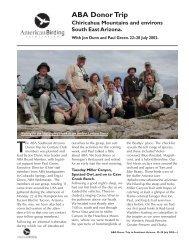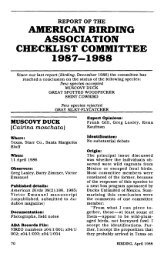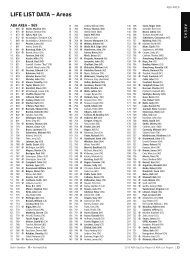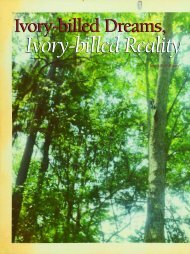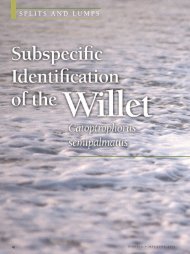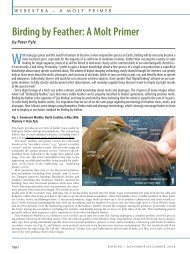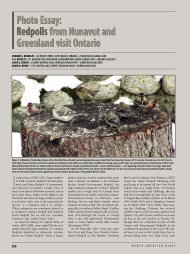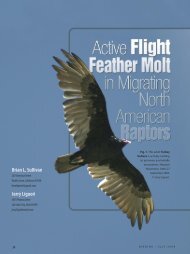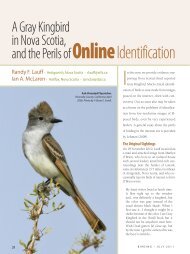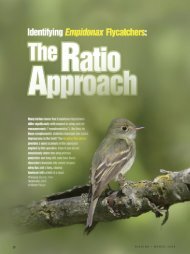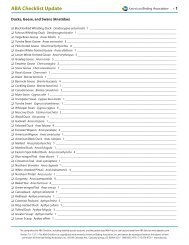2011 ABA Big Day & List Report - ABA Listing Central - American ...
2011 ABA Big Day & List Report - ABA Listing Central - American ...
2011 ABA Big Day & List Report - ABA Listing Central - American ...
- No tags were found...
You also want an ePaper? Increase the reach of your titles
YUMPU automatically turns print PDFs into web optimized ePapers that Google loves.
Mattamuskeet NWR, Alligator River NWR, Roanoke Island, Bodie Island, Pea Island NWR.Species of Note: Eurasian Wigeon (R,S)Lincoln’s Sparrow (R), Glossy Ibis (L), House Sparrow (M), <strong>American</strong> Goldfinch (M),Brown Thrasher (M), Eastern Screech-Owl (M), Blue Jay (M).Comments: At Pea Island NWR shortly before dusk, our car got stuck in some deepsand along the shoulder of Highway 12. With the assistance of 3 nearby folks, we wereable to push it out quickly and lost no more than 5 minutes of time!While driving along a refuge road at Alligator River NWR in early afternoon, we spotteda Bobcat sitting peacefully in an open area barely 25 meters off the road. It allowedus to exit the car and photograph it for several minutes before nonchalantly meanderingoff through the brush.NORTH DAKOTA #1 – 24 May 11 – 0200 to 2230 – Species totals: 168/163.(Team/shared). David Lambeth (165), Chris Merkord (168), Stephen Rossiter (165). Milesby Car: 225. Miles by Foot: 5. Visiting: Kellys Slough NWR and associated WaterfowlProduction Areas; Grand Forks County Prairie Chicken Management Area, Turtle RiverState Park, Riverside Park, Grand Forks Red River Greenway, English Coulee Greenway,Grand Forks lagoons, Oakville/Fairfield Grasslands, Grand Forks Memorial Park Cemetery.Comments: The strategy for this big day was to cover a relatively small geographicalarea that we knew well and to maximize the variety of habitats birded. The area coveredwas all within Grand Forks County; almost all within the eastern half. The total of 168species sets a new record for the state as well as a county within the state. Weather conditionswere cold for this late day in May (low 42, high 59), overcast, with northerly windsup to 18 mph. These conditions resulted in a major grounding of late migrants, producing20 species of warblers, 20 species of shorebirds, and 5 species of vireos. None of thespecies recorded were particularly rare for this area although there were many that cannotbe categorized as expected this late in the migration.SOUTH CAROLINA #1 – 21 February 11 – 0500 to 2200 – Species totals: 136/136.(Team/shared). J. D. Willson (136), Matt Malin (136), Mark Vukovich (136). Miles by Car:331. Miles by Foot: 3. Visiting: Hilton Head Island, Fish Haul Creek, Donnelley WMA,Bear Island WMA, Botany Bay WMA. Species of Note: Wilson’s Plover (E), Purple Sandpiper(R), Caspian Tern (E), Red-cockaded Woodpecker (R,S), Henslow’s Sparrow (R,S).TEXAS #1 – 22 Apr 11 – 0000 to 2359 – Species totals: 264/251. (Team/shared). JessieH. Barry (256), Andrew Farnsworth (258), Marshall J. Iliff (255), Timothy C. Lenz (256),Brian L. Sullivan (258), Christopher L. Wood (259). Miles by Car: 750. Miles by Foot: 3. Visiting:San Antonio, Uvalde, Concan, Sabinal, Victoria, Dupont Wetlands, Calhoun County,Rockport, Corpus Christi, Mustang Island. Species of Note: Snow Goose (L), Bufflehead(L), Least Bittern (M), Glossy Ibis (R), Black Rail (R), Swallow-tailed Kite (R), Snowy Plover(M), Hudsonian Godwit (M), Red Knot (M), Short-billed Dowitcher (M), Elf Owl (V), BeltedKingfisher (L), Pileated Woodpecker (R), Acadian Flycatcher (M), Western Scrub-Jay (M),Warbling Vireo (M), Brown Thrasher (L), Sprague’s Pipit (L), Magnolia Warbler (M), ProthonotaryWarbler (M), Scarlet Tanager (M), Rose-breasted Grosbeak (M), Lazuli Bunting(R), Audubon’s Oriole (R).Comments: New United States <strong>Big</strong> <strong>Day</strong> record. Raised $200,000+ for the CornellLab of Ornithology programs.The Cornell Lab of Ornithology has long participated in the World Series of Birding asone of its most important fundraisers of the year. In fact, fundraising totals have recentlyexceeded $200,000, all going towards Lab projects that support the study and protectionof birds. Team Sapsucker has won the World Series several times and consistently postedtotals among the top two or three. However, in 2010 the team decided to try a run at thenational record by visiting Texas.Team members Iliff, Farnsworth, and Barry are veterans of the Great Texas Birding Classic,so had done several previous <strong>Big</strong> <strong>Day</strong>s in the area. In particular, Iliff and Farnsworthhad lbeen actively discussing an attempt at the national record since 1998! The route wewould use became clear when Giff Beaton et al. improved upon the old national record(231) and upped it to 258 in 2001; Pete Hosner, Cameron Cox, Ken Behrens, and MichaelRetter further improved upon the total in 2009, finding 261 species. Our success drewheavily on those previous attempts.Being such an important fundraiser, it was possible to devote a lot of resources to scouting,which (as on any <strong>Big</strong> <strong>Day</strong>) is a huge advantage. In <strong>2011</strong>, our scouting group includeda full week of effort by all six team members, along with dedicated additional scouting byKen Rosenberg, Nathan Senner, and Lewis Grove. Local contacts gave us countless tidbitsof information too, with special thanks to Willie Sekula and Mel Cooksey, as well asMichele Crawford who helped us extensively in the Uvalde area. In the Hill Country, Neal’sLodge provided us with great lodging and food throughout our Hill Country scouting, andbeing well rested and well-fed is certainly one of the keys to successful scouting, lessonthat my team can contest it has taken me a while to learn!Our route mostly mirrored those of past <strong>Big</strong> <strong>Day</strong>s in the area, starting in the Texas HillCountry and then beelining to the coast, covering the section from Corpus Christi andMustang Island north to Calhoun County ricefields. However, our route was novel in acouple ways. We reversed the order on the coast, covering Victoria and Calhoun Countyfirst and then working south. We thought this accomplished two things. First, it allowedus to do our eastern landbirding in Victoria, rather than on southern the Guadalupe Riverwhere the key species are fewer and much harder to find. Second, giving migrants moretime to arrive on the coast is generally good strategy, since the numbers generally buildover the course of the day. Since the timing was about the same, we decided to make thischange. And finally, we really relished the idea of being at Port Aransas for dusk. Selectinga good day for migrants is a key part of the strategy in Texas, but we delayed as longas possible awaiting good conditions and finally ran the day on Friday, 22 April.Our quest began at midnight with a Yellow-crowned Night-Heron and Barred Owl in theglow of park lights near San Antonio’s famous Riverwalk, quickly followed by our only<strong>American</strong> Robin sitting on a nest nearby. With a calling Common Pauraque, we left the SanAntonio area and beelined to Sabinal, Concan, and Uvalde, where we got four more owls,including an Elf Owl that we found just three days earlier that apparently established a firstcounty record for Uvalde County! Chuck-will’s-widow, Common Poorwill, and some keyducks rounded out our nocturnal birding and we met dawn at Cook’s Slough just south ofUvalde. As the dawn chorus began we left and dashed to a certain suburban yard in suburbanUvalde where three key targets sounded off in quick succession, right on cue: BlueJay, Green Jay, an Audubon’s Oriole. At 7:03, we dashed back to Cook’s Slough andwalked the trails, picking up key brush country and pond species. A circuitous route aroundUvalde connected some other key species, as we worked our way north towards Concan.Once in the true Hill Country, a new set of birds greeted us, including Golden-cheekedWarbler, Eastern and Black Phoebes, Scott’s Oriole, Hutton’s and Black-capped Vireo, Rufous-crownedand Field Sparrows, and many more. With Western Scrub-Jay our only badmiss from the entire morning run, and rarities like Belted Kingfisher and Sprague’s Pipit inthe bag, we left the Hill Country at 10:10 and started heading coastward, with quick stopsfor Brewer’s Blackbird, Northern Bobwhite (missed), and Harris’s Hawk en route. Passingthrough San Antonio more than an hour later, we managed Monk Parakeet seen by all butthe driver (Marshall) from the Interstate, and scanned for hawks on the couple hour driveto Victoria, picking up Broad-winged Hawk and Mississippi Kite. In one particularly activekettle, Brian called for a stop and we got out and scanned, with Andy finding a surpriseSwallow-tailed Kite at truly stratospheric heights, surely the pick of the day (with partialcredit to Brian’s raptor-finding instincts).As we pulled into Victoria, Andy and Brian ran us through a quick route that netted alame Snow Goose (barely; it was sleeping hidden behind one of the only bushes!), NorthernParula, <strong>American</strong> Crow, Great Crested Flycatcher, Downy, Red-bellied, and PileatedWoodpeckers, the latter a scouting triumph on its nest in a telephone pole. From here itwas on to the Dupont Wetlands, which had Least Grebe, our first herons and egrets, andnearly all the freshwater shorebirds that a retention pond could offer including an earlyWhite-rumped. White-tailed Hawk and Bank Swallow fell along the road and a wellscoutedroadside duck stop had late Bufflehead and Red-breasted Merganser. We beelinedto the rice fields, which were in great condition and we picked up 7 key species,including Buff-breasted Sandpiper, <strong>American</strong> Golden-Plover, and even a couple of GlossyIbis. In one of the day’s few errors, we then elected to try for Fulvous Whistling-Duck andadded a 20 minute detour that got us no birds (and our backup Fulvous were properly inposition an hour later anyway, not to mention additional birds at dusk). Although BaldEagle and Anhinga (an unshared bird, after one seen by just one at Cook’s Slough) wouldelude us, other key scouting pickups included Le Conte’s Sparrow and our only WhitetailedKite as we sped towards Corpus Christi and began the migrant and coastal portionof the route. Chris took the wheel here, dodging traffic and trying to make up some time.Although Brian and Andy had been allotted an hour more than their route needed (theyran Victoria to Rockport expertly in just 2.5 hours), we had badly mistimed the drive fromSabinal to Victoria and were slightly behind schedule, so we had to cut stops for SnowyPlover and Monk Parakeet (another 95% bird).Our first stop was at famous Blucher Park, where we found few migrants and had towork for every one: Ovenbird seen by some...Common Nighthawk seen by some...HoodedWarbler...a continuing Brown Thrasher...Buff-bellied Hummingbird. From there we dashedto Hans Suter Park, which gave our first real rush of coastal waterbirds. We picked up anumber of key birds here, including Black Tern and Swamp Sparrow (unshared). A detourout past Texas A&M got us a few more, including Whimbrel and Piping Plover, but still noSnowy Plovers. Oso Bay had a mixed scaup flock and a surprise Merlin. Packery Channelwas similarly bleak for migrants, but we picked up a few more additions including ouronly Eastern Kingbird. As we headed north we got Common Tern out of the way and Andyhad another great pick from the car with our only Peregrine. The daylight was waning andwe were counting on the Port Aransas Birding Center and Paradise Pond to get us a slugof much-needed migrants, which would be make or break for our day. Perhaps the best<strong>2011</strong> <strong>ABA</strong> <strong>Big</strong> <strong>Day</strong> <strong>Report</strong> & <strong>ABA</strong> <strong>List</strong> <strong>Report</strong> | 15



